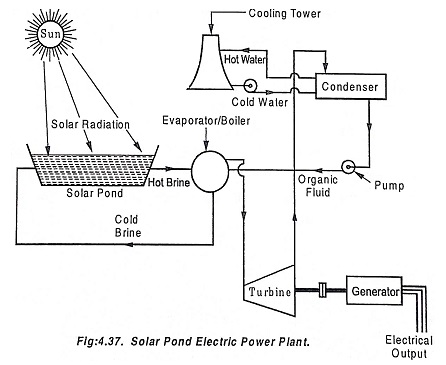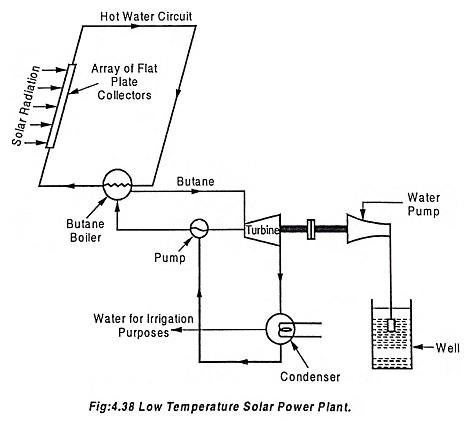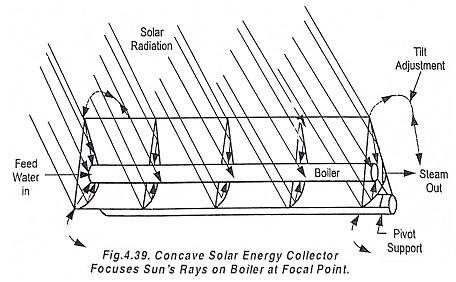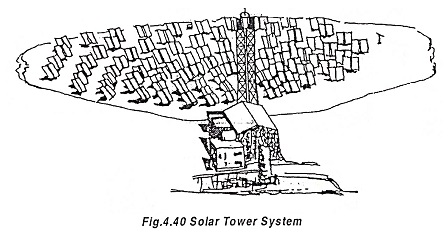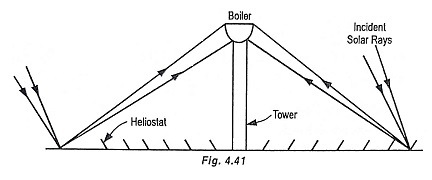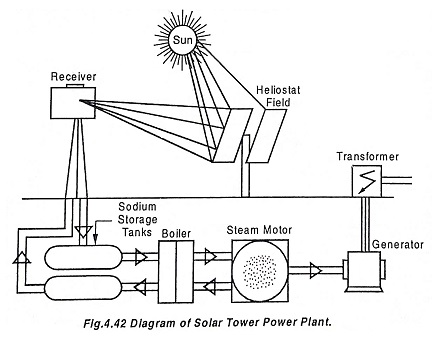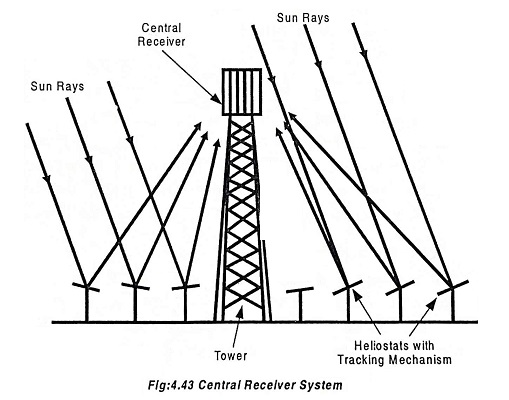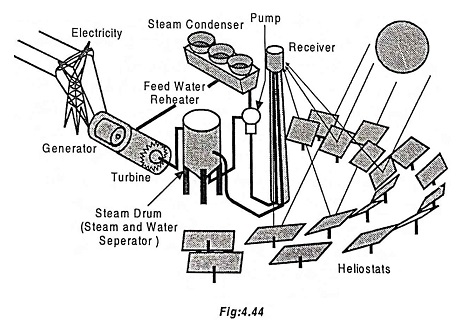Types of Solar Power Plant:
The surface of earth receives energy of 1014 kW from the sun. It is evident that sun will last for 1011 year. Even though the sun light is filtered by atmosphere, for every one square meter of land exposed to direct sun light receives the energy of 1 HP (or) 1 kW.
There are two obstacles to harness solar energy, one is the energy is not constantly available on earth so storage is needed to sustain a solar power system through the night and during bad weather conditions. Second the solar energy is diffused (i.e.,) scattered all over. Since the total amount of energy available is enormous, the collection and conservation of solar energy should be carried out over a large area, which requires large capital investment for the conversion apparatus.
Types of solar power plant are
- Solar pond electric power plant
- Low temperature solar power plant
- Medium temperature systems using focusing – collector
- High temperature systems – [solar farm and solar power plant]
(i) Solar pond electric power plant
A low temperature thermal electric power production scheme using solar pond is shown schematically in Fig.4.37. The energy obtained from a solar pond is used to drive a Rankine cycle heat engine. Hot water from the bottom level of the pond is pumped to boiler where the organic working fluid is vapourized. The vapour then flows under high pressure to the turbine where it expands and runs an electric generator producing electricity. The exhaust vapour is then condensed in a condenser and the liquid is pumped back to the evaporator and the cycle is repeated.
In Australia, a 2000 sq.m solar pond equipped with a 20 kW engine has been installed.
(ii) Low temperature solar Power Plant
Fig.4.38 shows a schematic diagram of a low temperature solar power plant. In this types of solar power plant system, an array of flat plate collectors is used to heat water to about 70°C and then this heat is used to boil butane in a heat exchanger. The high pressure butane vapour thus obtained runs a butane turbine which in turn operates a hydraulic pump which pumps the water from well for irrigation purposes. The exhaust butane vapour (from butane turbine) is condensed with the help of water which is pumped by the pump and the condensate is returned to the heat exchanger (or boiler).
(iii) Medium Temperature Systems Using Focusing Collectors
A circular or rectangular parabolic mirrors can collect the radiation and focus it on to a small area. A mechanism for moving the collector to follow the sun is necessary. Such devices are used for metallurgical research where high purity and high temperature are essential. For example, a 55 m diameter collector is giving about 1 MW (th) at Mont Louis in Pyrenees. Smaller units having 20 m diameter reflector can give temperature of 300°C over an area of about 50 m2. The collector efficiency is about 50%. On a small scale, units about 1 m diameter giving temperature of about 300°C are being used for cooking purposes.
Fig.4.39 shows a concave solar energy collector focusing sun’s rays on boiler at a focal point. Generation of steam at 250°C could give turbine efficiencies up to 20 -25 per cent.
(iv) High Temperature Systems – Solar Farm and Solar Power Plant
For a large Scale production of solar-heat, the following two concepts are available:
- The solar farm: It consists of a whole field covered with parabolic trough concentrators.
- The solar tower: It consists of a central receiver on a tower and a whole field of tracking.
In case of a ‘solar farm’, temperature at the point of focus can reach several hundred degrees celsius. Fig. 4.40 shows a solar tower systems.
In case of central receiver “solar tower” concentrators, temperature can reach thousands of degrees celsius, since a field of reflectors (heliostats) are arranged separately on sun-tracking frames to reflect the sun on to a boiler mounted on a central tower. (Fig.4.41).
With both systems (`solar farm’ and ‘solar tower’), a heat transfer fluid of gas is passed through the point or line of insolation concentration to collect the heat and transfer it to the point of use. Such heat can be used either directly in industrial or commercial processes or indirectly in electricity production via. steam turbine.
The solar technologies discussed in the above two systems that produce very hot water or steam are currently still under development and, in general, these technologies are not cost competitive with conventional power sources such as oil or gas.
Solar Central Receiver system
Power plant ranging from 50 MW to 200 MW comes under Central Receiver systems. In central receivers system, several heliostats are located on ground level and focussed to central receivers, mounted on tall tower.
The system is sub divided into following subsystems.
- The tower with central receiver
- Heat conversion system
- Heat storage device
- Heliostats
(i) The tower with central receiver
Heliostats placed in ground level redirects the sun ray’s towards a receiver at the top of the tower. The central receiver is responsible for transforming the concentrated radiation into heat.
(ii) Heat conversion system
The water at high pressure (100 atm) is allowed to pass through heat conversion system in the tower and the water is converted into superheated steam (500°C).
Then the steam is piped to ground level to drive turbine system. Air and organic salts also used as working fluid which can be used to increase performances of gas turbine by intake air heating at the entrance of combustion chamber.
(iii) Heat storage devices
The short term heat storage is provided by, fire bricks, fixed salt, sulphur, ceramic oxides. The selection of conventional storage material is determined by its corrosion characteristics, cost, convenience of use, thermal conductivity and operating temperature of working fluids.
(iv) Heliostats (Mirrors)
The glass mirrors are manufactured by using metalization flexible plastic sheets. The glass mirror produced must be capable to withstand wind load without any supporting structure and the glass mirrors should be steerable.
The system consists of a central stationary receiver to which the solar radiation is reflected by heliostats. A heliostat is composed of a large array of mirrors fixed with a tracking mechanism to track the sun as desired. They focus solar radiation on a central receiver which is stationary. High concentration ratio can be achieved.
The Fig.4.44 shows a solar central receiver system. The absorbed energy from the tower is extracted from the receiver by means of converting water into steam at suitable temperature and pressure, then the steam passes through steam drum and separate water and also used to store steam. Then steam at suitable temperature and pressure is allowed to pass through turbines for power generation. Then the steam passes through the condenser and gets condensed into water. This process continues again by pumping water to receiver with suitable pressure.
